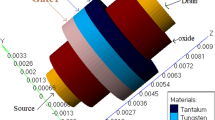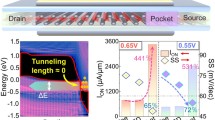Abstract
The conventional reverse-conducting lateral insulated-gate bipolar transistor (LIGBT) is mainly used as an inverter in industry, but its snapback effect and trade-off property are not ideal. Based on this, a compound LIGBT embedded separated conduction region, called SCR-LIGBT, is proposed for performance optimization. The electrical properties are investigated by numerical simulation. This device is a hybrid structure of LIGBT and laterally diffused metal–oxide–semiconductor (LDMOS). The LDMOS region is sandwiched by the LIGBT region, and they are isolated by a thin oxide layer. The triple gate is constructed by the trench gate of the LIGBT regions and the planar gate of the LDMOS region. The trench gate also acts as a side gate of the LDMOS region. The planar gate is a dummy gate which is directly connected to the emitter in the LDMOS region. At the forward conduction region, the conduction current is switched from unipolar mode (LDMOS domain) to bipolar mode (LIGBT domain) without snapback, due to the separated conduction regions. At the reverse conduction region, the parasitic P-base/n-drift/N-collector diode and the MOS diode of the LDMOS region realize reverse conduction capability. During the turn-off process, the LDMOS region is used to extract excess electrons. Under the same forward voltage of 1.18 V, the turn-off energy loss of the SCR-LIGBT is 37.3% lower than that of the conventional LIGBT. As a result, the SCR-LIGBT achieves a snapback-free and superior trade-off relationship between the on-state voltage drop (\(V_{\textrm{ON}}\)) and turn-off energy loss \(E_{\textrm{OFF}}\) of the device, and it improves the integration of the chip, with improved reliability.













Similar content being viewed by others
References
Iwamuro, N. and T. Laska. 2017. Igbt history, state-of-the-art, and future prospects. IEEE Trans. Electron Devices 64: 741.
F. Udrea, Soi-based devices and technologies for high voltage Ics, in IEEE Bipolar/BiCMOS Circuits and Technology Meeting, 74 (2007)
M. Qiao, B. Zhang, Z. Xiao, J. Fang and Z. Li, High-voltage technology based on thin layer soi for driving plasma display panels, in International Symposium on Power Semiconductor Devices and IC’s, p 52.
Sun, W., J. Zhu, L. Zhang, H. Yu, Y. Du, K. Huang, S. Lu, L. Shi and Y. Yi. 2015. A novel silicon-on-insulator lateral insulated-gate bipolar transistor with dual trenches for three-phase single chip inverter Ics. IEEE Electron Device Lett. 36: 693.
Chen, W., Z. Wei, H. Zhang, Y. Huang and Z. Han. 2023. An SOI ltigbt with self-biased pmos for improved short-circuit property and reduced turn-off loss. IEEE Trans. Electron Devices 70: 1751.
Ogura, T., H. Ninomiya, K. Sugiyama and T. Inoue. 2004. Turn-off switching analysis considering dynamic avalanche effect for low turn-off loss high-voltage igbts. IEEE Trans. Electron Devices 51: 629.
Y. Takahashi and M. Aono, 1200v reverse conducting igbt, in Proceedings of the 16th International Symposium on Power Semiconductor Devices and ICs, p 133, 2004
P.A. Gough, M.R. Simpson and V. Rumennik, Fast switching lateral insulated gate transistor, in International Electron Devices Meeting, p 218, 1986
Deng, G., X.R. Luo, J. Wei, K. Zhou, L. Huang, T. Sun, Q. Liu and B. Zhang. 2018. A snapback-free reverse conducting insulated-gate bipolar transistor with discontinuous field-stop layer. IEEE Trans. Electron Devices 65: 1856.
Wu, J., H. Huang, B. Yi, H. Hu, H. Hu and X.B. Chen. 2019. A snapback-free and low turn-off loss reverse-conducting SOI-LIGBT with embedded diode and mosfet. IEEE J. Electron Devices Soc. 7: 1013.
Chen, W., Y. Huang, S. Li, Y. Huang and Z. Han. 2019. A snapback-free and low-loss rc-igbt with lateral fwd integrated in the terminal region. IEEE Access 7: 183589.
J.-H. Chul, D.-S. Byeon, J.-K. Oh, M.-K. Han and Y.-I. Choi, A fast-switching SOI sa-LIGBT without ndr region, in International Symposium on Power Semiconductor Devices & ICs. Proceedings, p 149, 2000.
L. Zhang, J. Zhu, W. Sun, Y. Du, H. Yu, K. Huang and L. Shi, A high current density SOI-LIGBT with segmented trenches in the anode region for suppressing negative differential resistance regime, in IEEE International Symposium on Power Semiconductor Devices & IC’s (ISPSD), p 49.
J. Oh, D.H. Chun, R. Oh and H.S. Kim A snap-back suppressed shorted-anode lateral trench insulated gate bipolar transistor (ltigbt) with insulated trench collector, in IEEE International Symposium on Industrial Electronics, p 1367, 2015.
Sun, L., B. Duan and Y. Yang. 2021. Novel snapback-free SOI LIGBT with shorted anode and trench barriers. IEEE Trans. Electron Devices 68: 2408.
Chen, W., S. Li, Y. Huang, Y. Huang, L. He and Z. Han. 2020. Snapback-free rc-LIGBT with integrated LDMOS and LIGBT. Micro & Nano Lett. 15: 101.
Xia, Y., W. Chen, C. Liu, R. Sun, Z. Li and B. Zhang. 2022. An ultralow loss reverse-conducting LIGBT with embedded p-p-n diode in oxide trench. IEEE Trans. Electron Devices 69: 6956.
L. Sun, B. Duan, Y. Wang and Y. Yang, Fast-switching lateral igbt with trench/planar gate and integrated schottky barrier diode (sbd), in International Symposium on Power Semiconductor Devices and ICs (ISPSD), p 379, 2019
Yi, B., J. Lin, B. Zhang, J. Cheng and Y. Xiang. 2020. Simulation study of a novel snapback free reverse-conducting SOI-LIGBT with embedded p-type schottky barrier diode. IEEE Trans. Electron Devices 67: 2058.
Acknowledgments
This work was supported by the National Nature Science Foundation of China (Grants Nos.61604027) and the Key Scientific Research Project of Chongqing Municipal Education Commission under Grants KJZD-K202300610.
Funding
National Nature Science Foundation of China (Grants Nos.61604027). The Key Scientific Research Project of Chongqing Municipal Education Commission under Grants KJZD-K202300610.
Author information
Authors and Affiliations
Corresponding author
Ethics declarations
Conflict of interest
The authors declare that they have no known competing financial interests or personal relationships that could have appeared to influence the work reported in this paper.
Additional information
Publisher's Note
Springer Nature remains neutral with regard to jurisdictional claims in published maps and institutional affiliations.
Rights and permissions
Springer Nature or its licensor (e.g. a society or other partner) holds exclusive rights to this article under a publishing agreement with the author(s) or other rightsholder(s); author self-archiving of the accepted manuscript version of this article is solely governed by the terms of such publishing agreement and applicable law.
About this article
Cite this article
Chen, W., Li, C. & Shen, W. A Compound LIGBT with Separated Conduction Region for Elimination of the Snapback Effect and Improved Trade-Off Property. J. Electron. Mater. 53, 441–448 (2024). https://doi.org/10.1007/s11664-023-10790-3
Received:
Accepted:
Published:
Issue Date:
DOI: https://doi.org/10.1007/s11664-023-10790-3




